Abstract
An immunodominant Epstein-Barr virus (EBV)-encoded cytotoxic T lymphocyte (CTL) epitope has been mapped to the EBV nuclear antigen 3A. The epitope, represented by the peptide sequence AWNAGFLRGRAYGLD (hereafter termed AWNA), is restricted through the HLA-B8 allele and is expressed by type A but not type B-infected transformants. Herein, we show that EBV-specific memory CTLs from an HLA-B8+ healthy virus carrier, JS, did not respond in vitro to AWNA, even though that individual's endogenously infected transformants processed and presented the natural equivalent of this peptide to AWNA-specific CTLs from another B8+ individual. Instead, an epitope, represented by the peptide sequence QLSDTPLIPLTIFVGENTGV, was the dominant EBV-specific CTL epitope in donor JS. This epitope mapped to EBV nuclear antigen 2A, was restricted by an HLA-A2 subtype, and specifically associated with type A strains of EBV. No AWNA-specific CTL precursors were detected by limiting dilution analysis of peripheral blood mononuclear cells from donor JS whereas the precursor frequency of AWNA-specific CTLs from a responder donor, LC, was estimated at 1:4500. The presentation in vivo of an immunogenic epitope-HLA antigen complex is clearly insufficient to guarantee an effective memory CTL response to that foreign epitope. Thus, vaccination strategies based on peptides inducing CTL responses may need to take into account not only the polymorphism of HLA antigens but also possible allelic variation in the repertoires of T-cell receptors.
Full text
PDF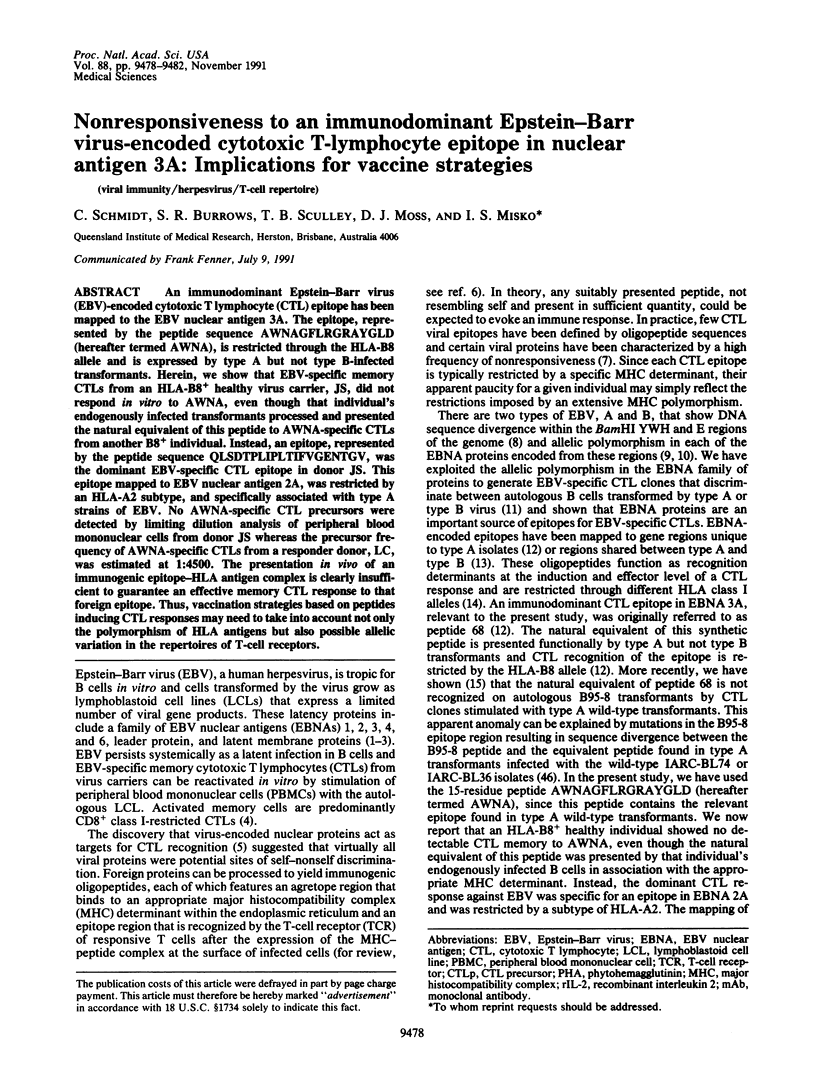
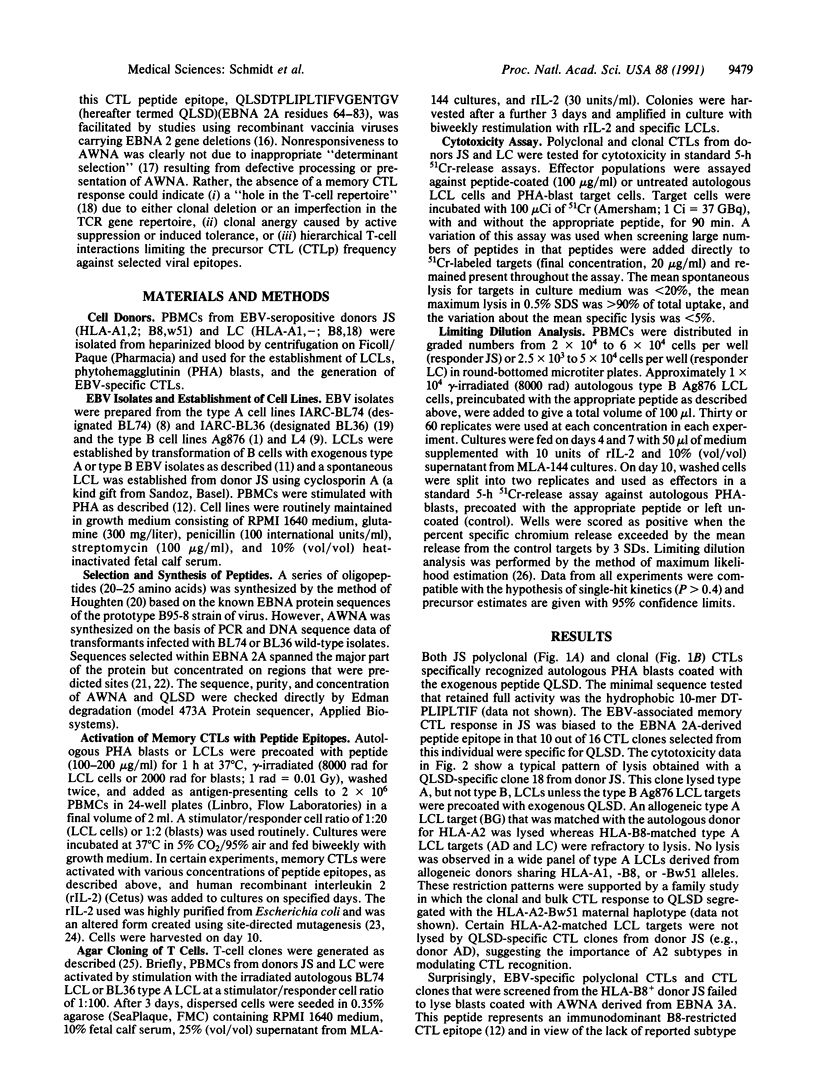
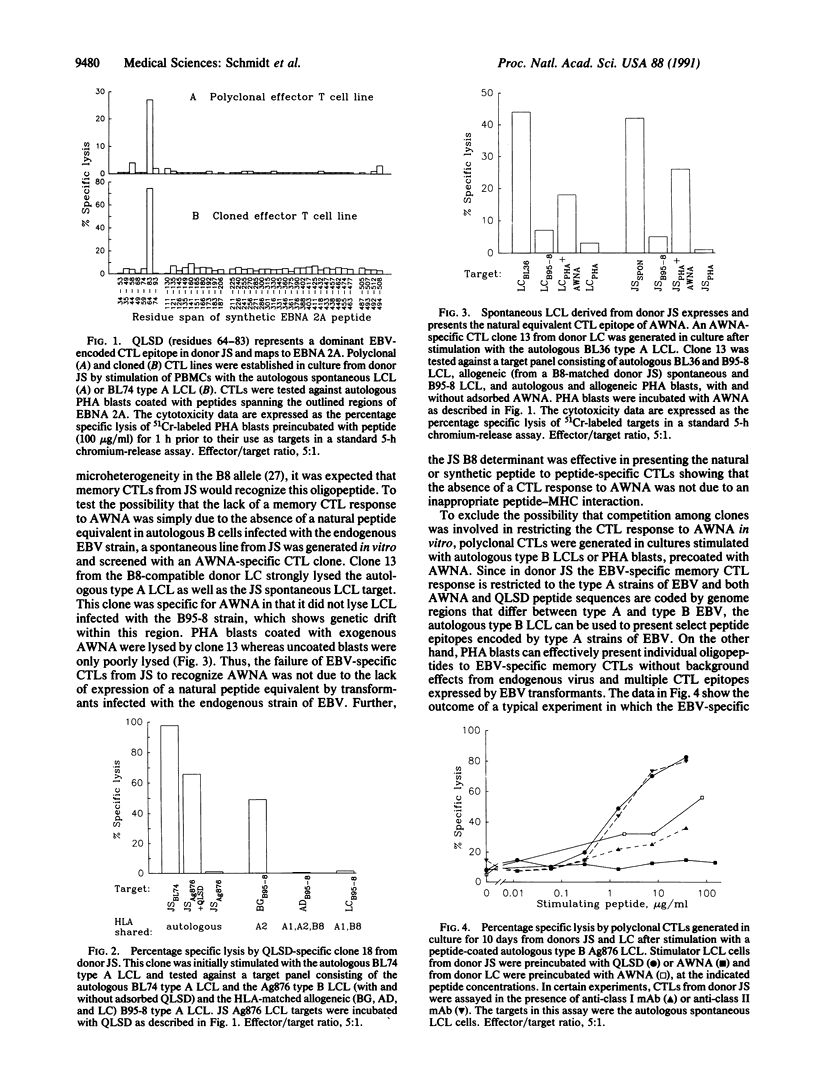
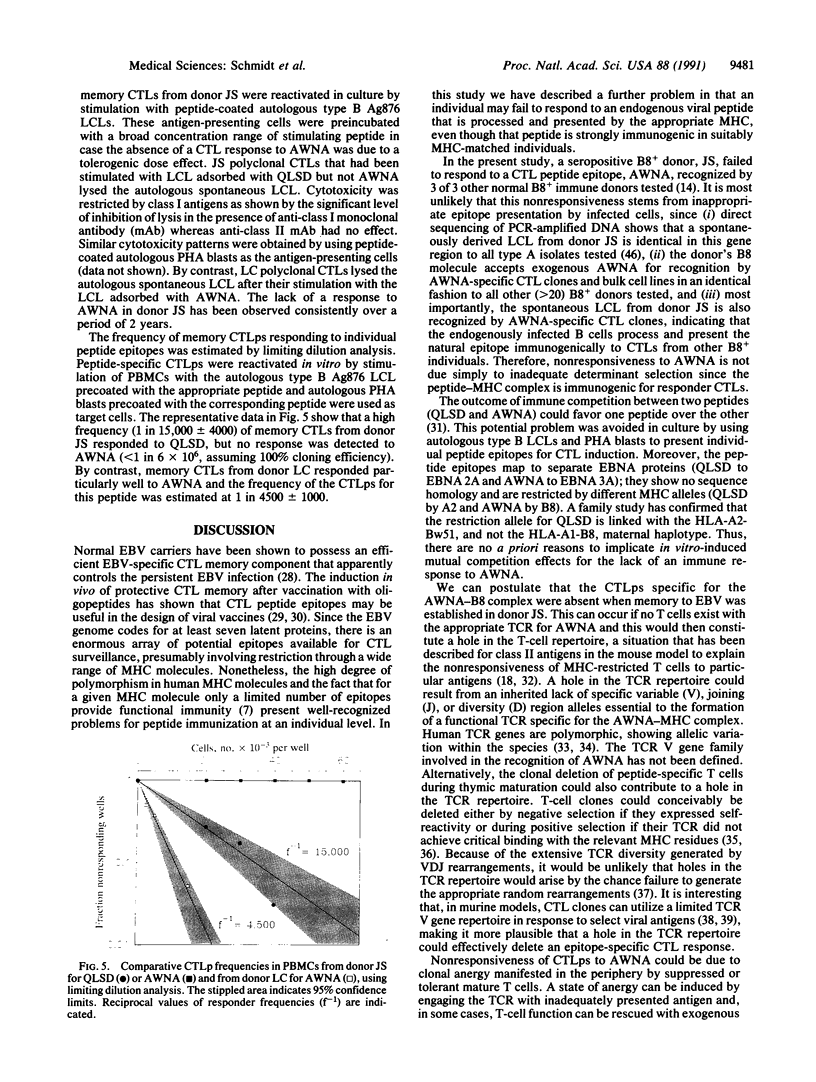
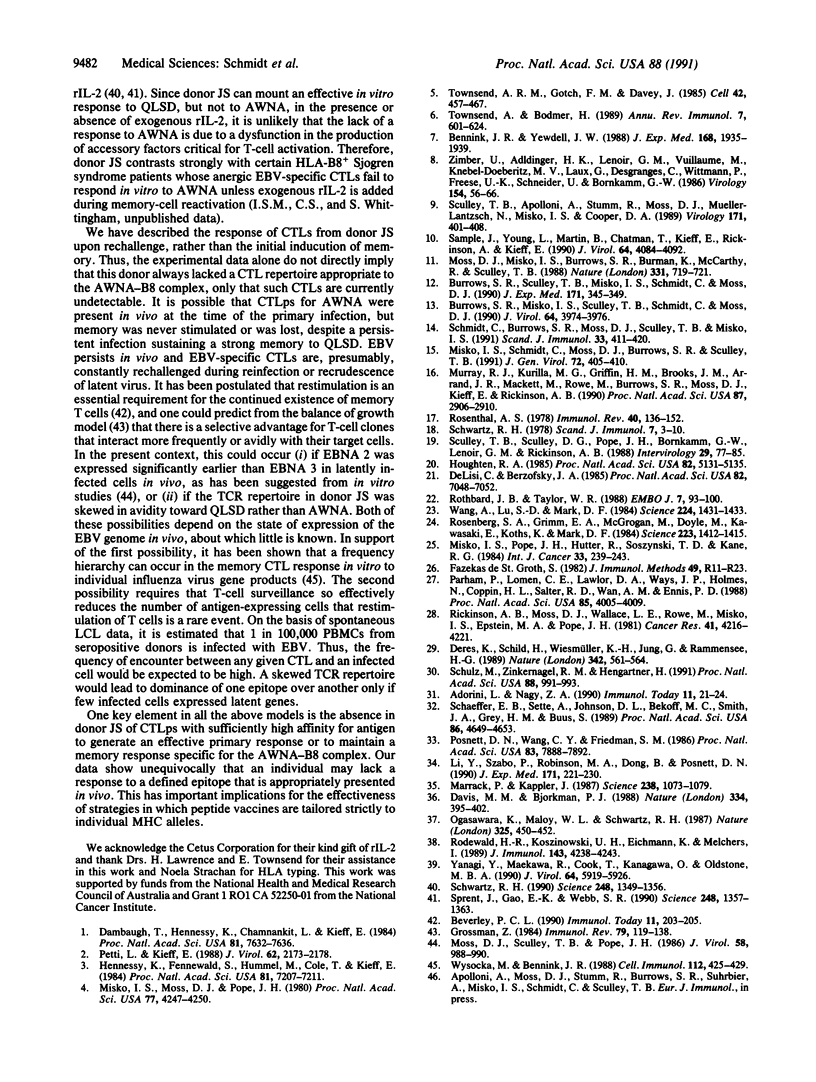
Images in this article
Selected References
These references are in PubMed. This may not be the complete list of references from this article.
- Adorini L., Nagy Z. A. Peptide competition for antigen presentation. Immunol Today. 1990 Jan;11(1):21–24. doi: 10.1016/0167-5699(90)90006-u. [DOI] [PubMed] [Google Scholar]
- Bennink J. R., Yewdell J. W. Murine cytotoxic T lymphocyte recognition of individual influenza virus proteins. High frequency of nonresponder MHC class I alleles. J Exp Med. 1988 Nov 1;168(5):1935–1939. doi: 10.1084/jem.168.5.1935. [DOI] [PMC free article] [PubMed] [Google Scholar]
- Beverley P. C. Is T-cell memory maintained by crossreactive stimulation? Immunol Today. 1990 Jun;11(6):203–205. doi: 10.1016/0167-5699(90)90083-l. [DOI] [PubMed] [Google Scholar]
- Burrows S. R., Misko I. S., Sculley T. B., Schmidt C., Moss D. J. An Epstein-Barr virus-specific cytotoxic T-cell epitope present on A- and B-type transformants. J Virol. 1990 Aug;64(8):3974–3976. doi: 10.1128/jvi.64.8.3974-3976.1990. [DOI] [PMC free article] [PubMed] [Google Scholar]
- Burrows S. R., Sculley T. B., Misko I. S., Schmidt C., Moss D. J. An Epstein-Barr virus-specific cytotoxic T cell epitope in EBV nuclear antigen 3 (EBNA 3). J Exp Med. 1990 Jan 1;171(1):345–349. doi: 10.1084/jem.171.1.345. [DOI] [PMC free article] [PubMed] [Google Scholar]
- Dambaugh T., Hennessy K., Chamnankit L., Kieff E. U2 region of Epstein-Barr virus DNA may encode Epstein-Barr nuclear antigen 2. Proc Natl Acad Sci U S A. 1984 Dec;81(23):7632–7636. doi: 10.1073/pnas.81.23.7632. [DOI] [PMC free article] [PubMed] [Google Scholar]
- Davis M. M., Bjorkman P. J. T-cell antigen receptor genes and T-cell recognition. Nature. 1988 Aug 4;334(6181):395–402. doi: 10.1038/334395a0. [DOI] [PubMed] [Google Scholar]
- DeLisi C., Berzofsky J. A. T-cell antigenic sites tend to be amphipathic structures. Proc Natl Acad Sci U S A. 1985 Oct;82(20):7048–7052. doi: 10.1073/pnas.82.20.7048. [DOI] [PMC free article] [PubMed] [Google Scholar]
- Deres K., Schild H., Wiesmüller K. H., Jung G., Rammensee H. G. In vivo priming of virus-specific cytotoxic T lymphocytes with synthetic lipopeptide vaccine. Nature. 1989 Nov 30;342(6249):561–564. doi: 10.1038/342561a0. [DOI] [PubMed] [Google Scholar]
- Fazekas de St Groth The evaluation of limiting dilution assays. J Immunol Methods. 1982 Mar 12;49(2):R11–R23. doi: 10.1016/0022-1759(82)90269-1. [DOI] [PubMed] [Google Scholar]
- Grossman Z. Recognition of self and regulation of specificity at the level of cell populations. Immunol Rev. 1984 Jun;79:119–138. doi: 10.1111/j.1600-065x.1984.tb00490.x. [DOI] [PubMed] [Google Scholar]
- Hennessy K., Fennewald S., Hummel M., Cole T., Kieff E. A membrane protein encoded by Epstein-Barr virus in latent growth-transforming infection. Proc Natl Acad Sci U S A. 1984 Nov;81(22):7207–7211. doi: 10.1073/pnas.81.22.7207. [DOI] [PMC free article] [PubMed] [Google Scholar]
- Houghten R. A. General method for the rapid solid-phase synthesis of large numbers of peptides: specificity of antigen-antibody interaction at the level of individual amino acids. Proc Natl Acad Sci U S A. 1985 Aug;82(15):5131–5135. doi: 10.1073/pnas.82.15.5131. [DOI] [PMC free article] [PubMed] [Google Scholar]
- Li Y., Szabo P., Robinson M. A., Dong B., Posnett D. N. Allelic variations in the human T cell receptor V beta 6.7 gene products. J Exp Med. 1990 Jan 1;171(1):221–230. doi: 10.1084/jem.171.1.221. [DOI] [PMC free article] [PubMed] [Google Scholar]
- Marrack P., Kappler J. The T cell receptor. Science. 1987 Nov 20;238(4830):1073–1079. doi: 10.1126/science.3317824. [DOI] [PubMed] [Google Scholar]
- Misko I. S., Moss D. J., Pope J. H. HLA antigen-related restriction of T lymphocyte cytotoxicity to Epstein-Barr virus. Proc Natl Acad Sci U S A. 1980 Jul;77(7):4247–4250. doi: 10.1073/pnas.77.7.4247. [DOI] [PMC free article] [PubMed] [Google Scholar]
- Misko I. S., Pope J. H., Hütter R., Soszynski T. D., Kane R. G. HLA-DR-antigen-associated restriction of EBV-specific cytotoxic T-cell colonies. Int J Cancer. 1984 Feb 15;33(2):239–243. doi: 10.1002/ijc.2910330212. [DOI] [PubMed] [Google Scholar]
- Misko I. S., Schmidt C., Moss D. J., Burrows S. R., Sculley T. B. Cytotoxic T lymphocyte discrimination between type A Epstein-Barr virus transformants is mapped to an immunodominant epitope in EBNA 3. J Gen Virol. 1991 Feb;72(Pt 2):405–409. doi: 10.1099/0022-1317-72-2-405. [DOI] [PubMed] [Google Scholar]
- Moss D. J., Misko I. S., Burrows S. R., Burman K., McCarthy R., Sculley T. B. Cytotoxic T-cell clones discriminate between A- and B-type Epstein-Barr virus transformants. Nature. 1988 Feb 25;331(6158):719–721. doi: 10.1038/331719a0. [DOI] [PubMed] [Google Scholar]
- Moss D. J., Sculley T. B., Pope J. H. Induction of Epstein-Barr virus nuclear antigens. J Virol. 1986 Jun;58(3):988–990. doi: 10.1128/jvi.58.3.988-990.1986. [DOI] [PMC free article] [PubMed] [Google Scholar]
- Murray R. J., Kurilla M. G., Griffin H. M., Brooks J. M., Mackett M., Arrand J. R., Rowe M., Burrows S. R., Moss D. J., Kieff E. Human cytotoxic T-cell responses against Epstein-Barr virus nuclear antigens demonstrated by using recombinant vaccinia viruses. Proc Natl Acad Sci U S A. 1990 Apr;87(8):2906–2910. doi: 10.1073/pnas.87.8.2906. [DOI] [PMC free article] [PubMed] [Google Scholar]
- Ogasawara K., Maloy W. L., Schwartz R. H. Failure to find holes in the T-cell repertoire. 1987 Jan 29-Feb 4Nature. 325(6103):450–452. doi: 10.1038/325450a0. [DOI] [PubMed] [Google Scholar]
- Parham P., Lomen C. E., Lawlor D. A., Ways J. P., Holmes N., Coppin H. L., Salter R. D., Wan A. M., Ennis P. D. Nature of polymorphism in HLA-A, -B, and -C molecules. Proc Natl Acad Sci U S A. 1988 Jun;85(11):4005–4009. doi: 10.1073/pnas.85.11.4005. [DOI] [PMC free article] [PubMed] [Google Scholar]
- Petti L., Kieff E. A sixth Epstein-Barr virus nuclear protein (EBNA3B) is expressed in latently infected growth-transformed lymphocytes. J Virol. 1988 Jun;62(6):2173–2178. doi: 10.1128/jvi.62.6.2173-2178.1988. [DOI] [PMC free article] [PubMed] [Google Scholar]
- Posnett D. N., Wang C. Y., Friedman S. M. Inherited polymorphism of the human T-cell antigen receptor detected by a monoclonal antibody. Proc Natl Acad Sci U S A. 1986 Oct;83(20):7888–7892. doi: 10.1073/pnas.83.20.7888. [DOI] [PMC free article] [PubMed] [Google Scholar]
- Rickinson A. B., Moss D. J., Wallace L. E., Rowe M., Misko I. S., Epstein M. A., Pope J. H. Long-term T-cell-mediated immunity to Epstein-Barr virus. Cancer Res. 1981 Nov;41(11 Pt 1):4216–4221. [PubMed] [Google Scholar]
- Rodewald H. R., Koszinowski U. H., Eichmann K., Melchers I. Predominant utilization of V beta 8+ T cell receptor genes in the H-2Ld-restricted cytotoxic T cell response against the immediate-early protein pp89 of the murine cytomegalovirus. J Immunol. 1989 Dec 15;143(12):4238–4243. [PubMed] [Google Scholar]
- Rosenberg S. A., Grimm E. A., McGrogan M., Doyle M., Kawasaki E., Koths K., Mark D. F. Biological activity of recombinant human interleukin-2 produced in Escherichia coli. Science. 1984 Mar 30;223(4643):1412–1414. doi: 10.1126/science.6367046. [DOI] [PubMed] [Google Scholar]
- Rosenthal A. S. Determinant selection and macrophage function in genetic control of the immune response. Immunol Rev. 1978;40:136–152. doi: 10.1111/j.1600-065x.1978.tb00404.x. [DOI] [PubMed] [Google Scholar]
- Rothbard J. B., Taylor W. R. A sequence pattern common to T cell epitopes. EMBO J. 1988 Jan;7(1):93–100. doi: 10.1002/j.1460-2075.1988.tb02787.x. [DOI] [PMC free article] [PubMed] [Google Scholar]
- Sample J., Young L., Martin B., Chatman T., Kieff E., Rickinson A., Kieff E. Epstein-Barr virus types 1 and 2 differ in their EBNA-3A, EBNA-3B, and EBNA-3C genes. J Virol. 1990 Sep;64(9):4084–4092. doi: 10.1128/jvi.64.9.4084-4092.1990. [DOI] [PMC free article] [PubMed] [Google Scholar]
- Schaeffer E. B., Sette A., Johnson D. L., Bekoff M. C., Smith J. A., Grey H. M., Buus S. Relative contribution of "determinant selection" and "holes in the T-cell repertoire" to T-cell responses. Proc Natl Acad Sci U S A. 1989 Jun;86(12):4649–4653. doi: 10.1073/pnas.86.12.4649. [DOI] [PMC free article] [PubMed] [Google Scholar]
- Schmidt C., Burrows S. R., Moss D. J., Sculley T. B., Misko I. S. Oligopeptide induction of a secondary cytotoxic T-cell response to Epstein-Barr virus in vitro. Scand J Immunol. 1991 Apr;33(4):411–420. doi: 10.1111/j.1365-3083.1991.tb01789.x. [DOI] [PubMed] [Google Scholar]
- Schulz M., Zinkernagel R. M., Hengartner H. Peptide-induced antiviral protection by cytotoxic T cells. Proc Natl Acad Sci U S A. 1991 Feb 1;88(3):991–993. doi: 10.1073/pnas.88.3.991. [DOI] [PMC free article] [PubMed] [Google Scholar]
- Schwartz R. H. A cell culture model for T lymphocyte clonal anergy. Science. 1990 Jun 15;248(4961):1349–1356. doi: 10.1126/science.2113314. [DOI] [PubMed] [Google Scholar]
- Schwartz R. H. A clonal deletion model for Ir gene control of the immune response. Scand J Immunol. 1978;7(1):3–10. doi: 10.1111/j.1365-3083.1978.tb00420.x. [DOI] [PubMed] [Google Scholar]
- Sculley T. B., Apolloni A., Stumm R., Moss D. J., Mueller-Lantczh N., Misko I. S., Cooper D. A. Expression of Epstein-Barr virus nuclear antigens 3, 4, and 6 are altered in cell lines containing B-type virus. Virology. 1989 Aug;171(2):401–408. doi: 10.1016/0042-6822(89)90608-9. [DOI] [PubMed] [Google Scholar]
- Sculley T. B., Sculley D. G., Pope J. H., Bornkamm G. W., Lenoir G. M., Rickinson A. B. Epstein-Barr virus nuclear antigens 1 and 2 in Burkitt lymphoma cell lines containing either 'A'- or 'B'-type virus. Intervirology. 1988;29(2):77–85. doi: 10.1159/000150032. [DOI] [PubMed] [Google Scholar]
- Sprent J., Gao E. K., Webb S. R. T cell reactivity to MHC molecules: immunity versus tolerance. Science. 1990 Jun 15;248(4961):1357–1363. doi: 10.1126/science.1694041. [DOI] [PubMed] [Google Scholar]
- Townsend A. R., Gotch F. M., Davey J. Cytotoxic T cells recognize fragments of the influenza nucleoprotein. Cell. 1985 Sep;42(2):457–467. doi: 10.1016/0092-8674(85)90103-5. [DOI] [PubMed] [Google Scholar]
- Townsend A., Bodmer H. Antigen recognition by class I-restricted T lymphocytes. Annu Rev Immunol. 1989;7:601–624. doi: 10.1146/annurev.iy.07.040189.003125. [DOI] [PubMed] [Google Scholar]
- Wang A., Lu S. D., Mark D. F. Site-specific mutagenesis of the human interleukin-2 gene: structure-function analysis of the cysteine residues. Science. 1984 Jun 29;224(4656):1431–1433. doi: 10.1126/science.6427925. [DOI] [PubMed] [Google Scholar]
- Wysocka M., Bennink J. R. Limiting dilution analysis of memory cytotoxic T lymphocytes specific for individual influenza virus gene products. Cell Immunol. 1988 Apr 1;112(2):425–429. doi: 10.1016/0008-8749(88)90311-5. [DOI] [PubMed] [Google Scholar]
- Yanagi Y., Maekawa R., Cook T., Kanagawa O., Oldstone M. B. Restricted V-segment usage in T-cell receptors from cytotoxic T lymphocytes specific for a major epitope of lymphocytic choriomeningitis virus. J Virol. 1990 Dec;64(12):5919–5926. doi: 10.1128/jvi.64.12.5919-5926.1990. [DOI] [PMC free article] [PubMed] [Google Scholar]
- Zimber U., Adldinger H. K., Lenoir G. M., Vuillaume M., Knebel-Doeberitz M. V., Laux G., Desgranges C., Wittmann P., Freese U. K., Schneider U. Geographical prevalence of two types of Epstein-Barr virus. Virology. 1986 Oct 15;154(1):56–66. doi: 10.1016/0042-6822(86)90429-0. [DOI] [PubMed] [Google Scholar]



